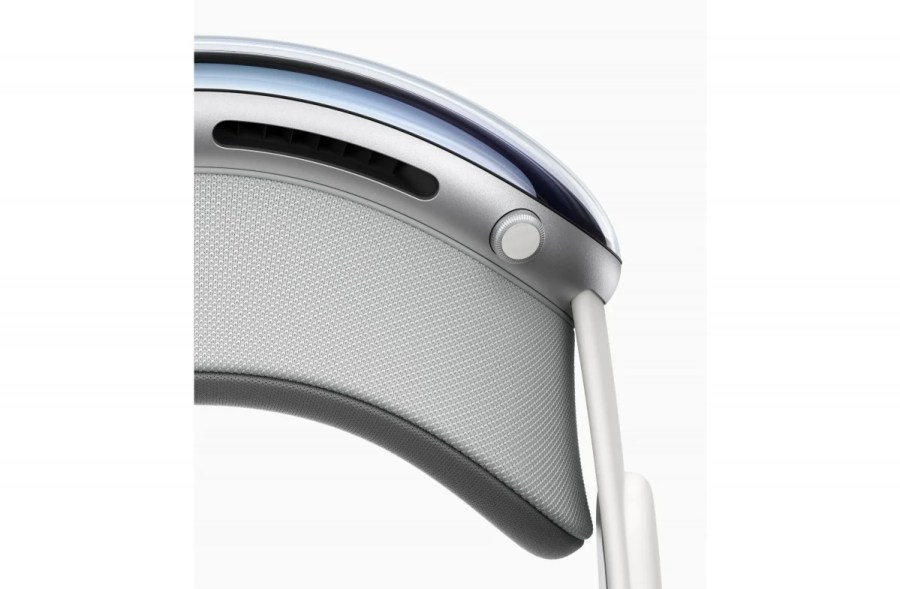They don’t even call it a VR/AR Headset, it’s a “spatial computer” as they dub it.

During last night’s WWDC, Apple launched several products and services including iOS 17 and the new M2 MacBook. However, one product that caught our attention the most is the new Vision Pro AR goggles which is billed by Apple as its “First Spatial Computer”. Knowing Apple, it took them years and years to craft a VR headset and just let the competition win until the right time arrives to release their own. Hence why they are yet to release a foldable iPhone.
The new headset is built from the ground up including a dedicated operating system called VisionOS. And, according to CEO Tim Cook, the Vision Pro is ahead of the competition “unlike anything created before”. This new OS comes with its own version of the App Store with apps sourced from both the iPad and the iPhone. FaceTime is also supported.

The headset is aided by a modified version of Apple’s M2 chip alongside the new R1 chip to help control the cameras. Its display allows for ultrawide vision, including peripheral vision and streams images at a rate of 12ms which is 8x faster than a blink of an eye.

The display system packs around 23 million pixels which is a higher resolution than most 4K TVs. This allows it to have pixel-sharp details as if you’re seeing the real world, albeit virtually. Also, for those with visual impairments, Apple has teamed up with Zeiss to bring its lenses onto the Vision Pro to allow for exceptionally accurate eye-tracking. Apps can appear side by side at any scale. This sounds quite like Sci-Fi but now it’s reality.
With a screen that “feels 100 feet wide”, you can now enjoy Apple Arcade titles in any screen size you want, bringing immersive gameplay to a whole new level of experience. The Vision Pro also has support for game controllers
Aside from that, the headset also supports Magic Keyboard and Magic Trackpad. Users can also access their favourite programs and apps from their iPhone or iPad if it supports it to bring a higher level of productivity beyond on what we already know.
There are no physical buttons on VisionOS, instead, everything is controlled by your senses, as well as voice. You can browse and open apps simply by looking at them, flicking your hands, or through a voice command.

When wearing VR headsets, you cannot see the person in front of you which can be distracting. To remedy that, Apple introduced a feature called EyeSight. When a person comes close to you, the headset can detect it and its display would become transparent. The other person can see your eyes and you can see them too (in the real world, of course). If you’re just having too much fun with your new “spatial computer”, EyeSight would signal others to let them know.

When using FaceTime, the goggles will create a “Persona” of yourself through various AI techniques. If this sounds familiar, that’s because the concept is highly similar to the Metaverse. This new FaceTime allows you to make calls in life-size tiles. And since Spatial Audio is supported, your video call will sound immersive and would come from where they are positioned.

The headset features a digital crown which allows you to zoom in and out. With the Vision Pro’s 3D camera (also a first for Apple), you can browse your photos and videos and immerse your favourite memories. Panoramic shots wrap around you so you could feel the entire scene as shot from your iPhone.

Finally, we should not forget how the Vision Pro is constructed. The frame is made using an aluminium alloy. The “Light Seal” is tailored using soft textiles in a wide array of shapes and sizes to ensure that your face perfectly fits while its flexible straps remain comfortable and as close to your ears as possible to fully take advantage of spatial audio.
The default headband is 3D knitted to ensure comfort and breathability. If this design is not your cup of tea, then you could easily swap it thanks to its simple mechanism.
It’s available for US users starting early next year with a price tag of USD 3,499 (~PHP 196.7K). With that said, you can already get a downpayment for a car, a house, and a 1TB iPhone 14 Pro Max (fully paid) with that price. For a normal US citizen, that’s probably 1 or 2 months’ worth of groceries.
It will then be available to other countries later in that year.
Source: Apple

You must be logged in to post a comment.